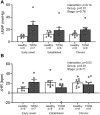Exaggerated exercise pressor reflex in male UC Davis type 2 diabetic rats is due to the pathophysiology of the disease and not aging
- PMID: 36703927
- PMCID: PMC9871248
- DOI: 10.3389/fphys.2022.1063326
Exaggerated exercise pressor reflex in male UC Davis type 2 diabetic rats is due to the pathophysiology of the disease and not aging
Abstract
Introduction: Studies in humans and animals have found that type 2 diabetes mellitus (T2DM) exaggerates the blood pressure (BP) response to exercise, which increases the risk of adverse cardiovascular events such as heart attack and stroke. T2DM is a chronic disease that, without appropriate management, progresses in severity as individuals grow older. Thus, it is possible that aging may also exaggerate the BP response to exercise. Therefore, the purpose of the current study was to determine the effect of the pathophysiology of T2DM on the exercise pressor reflex independent of aging. Methods: We compared changes in peak pressor (mean arterial pressure; ΔMAP), BP index (ΔBPi), heart rate (ΔHR), and HR index (ΔHRi) responses to static contraction, intermittent contraction, and tendon stretch in UCD-T2DM rats to those of healthy, age-matched Sprague Dawley rats at three different stages of the disease. Results: We found that the ΔMAP, ΔBPi, ΔHR, and ΔHRi responses to static contraction were significantly higher in T2DM rats (ΔMAP: 29 ± 4 mmHg; ΔBPi: 588 ± 51 mmHg•s; ΔHR: 22 ± 5 bpm; ΔHRi: 478 ± 45 bpm•s) compared to controls (ΔMAP: 10 ± 1 mmHg, p < 0.0001; ΔBPi: 121 ± 19 mmHg•s, p < 0.0001; ΔHR: 5 ± 2 bpm, p = 0.01; ΔHRi: 92 ± 19 bpm•s, p < 0.0001) shortly after diabetes onset. Likewise, the ΔMAP, ΔBPi, and ΔHRi to tendon stretch were significantly higher in T2DM rats (ΔMAP: 33 ± 7 mmHg; ΔBPi: 697 ± 70 mmHg•s; ΔHRi: 496 ± 51 bpm•s) compared to controls (ΔMAP: 12 ± 5 mmHg, p = 0.002; ΔBPi: 186 ± 30 mmHg•s, p < 0.0001; ΔHRi: 144 ± 33 bpm•s, p < 0.0001) shortly after diabetes onset. The ΔBPi and ΔHRi, but not ΔMAP, to intermittent contraction was significantly higher in T2DM rats (ΔBPi: 543 ± 42 mmHg•s; ΔHRi: 453 ± 53 bpm•s) compared to controls (ΔBPi: 140 ± 16 mmHg•s, p < 0.0001; ΔHRi: 108 ± 22 bpm•s, p = 0.0002) shortly after diabetes onset. Discussion: Our findings suggest that the exaggerated exercise pressor reflex and mechanoreflex seen in T2DM are due to the pathophysiology of the disease and not aging.
Keywords: autonomic control of circulation; blood pressure; cardiovascular response; mechanoreflex; metaboreflex.
Copyright © 2023 Huo, Grotle, McCuller, Samora, Stanhope, Havel, Harrison and Stone.
Conflict of interest statement
The authors declare that the research was conducted in the absence of any commercial or financial relationships that could be construed as a potential conflict of interest.
Figures






Similar articles
-
Interleukin-1 type 1 receptor blockade attenuates the exaggerated exercise pressor reflex in male UC Davis type 2 diabetic mellitus rats.J Physiol. 2024 Nov 18:10.1113/JP287120. doi: 10.1113/JP287120. Online ahead of print. J Physiol. 2024. PMID: 39557607
-
Exaggerated cardiovascular responses to muscle contraction and tendon stretch in UCD type-2 diabetes mellitus rats.Am J Physiol Heart Circ Physiol. 2019 Aug 1;317(2):H479-H486. doi: 10.1152/ajpheart.00229.2019. Epub 2019 Jul 5. Am J Physiol Heart Circ Physiol. 2019. PMID: 31274351 Free PMC article.
-
Effects of acute hyperglycemia on the exercise pressor reflex in healthy rats.Auton Neurosci. 2020 Dec;229:102739. doi: 10.1016/j.autneu.2020.102739. Epub 2020 Nov 5. Auton Neurosci. 2020. PMID: 33190039 Free PMC article.
-
Exaggerated exercise pressor reflex in type 2 diabetes: Potential role of oxidative stress.Auton Neurosci. 2019 Dec;222:102591. doi: 10.1016/j.autneu.2019.102591. Epub 2019 Oct 21. Auton Neurosci. 2019. PMID: 31669797 Free PMC article. Review.
-
Age-related alterations in the cardiovascular responses to acute exercise in males and females: role of the exercise pressor reflex.Front Physiol. 2023 Nov 2;14:1287392. doi: 10.3389/fphys.2023.1287392. eCollection 2023. Front Physiol. 2023. PMID: 38028783 Free PMC article. Review.
Cited by
-
Interleukin-1 type 1 receptor blockade attenuates the exaggerated exercise pressor reflex in male UC Davis type 2 diabetic mellitus rats.J Physiol. 2024 Nov 18:10.1113/JP287120. doi: 10.1113/JP287120. Online ahead of print. J Physiol. 2024. PMID: 39557607
-
Cyclooxygenase products contribute to the exaggerated exercise pressor reflex evoked by static muscle contraction in male UCD-type 2 diabetes mellitus rats.J Appl Physiol (1985). 2024 May 1;136(5):1226-1237. doi: 10.1152/japplphysiol.00879.2023. Epub 2024 Mar 28. J Appl Physiol (1985). 2024. PMID: 38545661 Free PMC article.
-
Hemodynamic responses to handgrip and metaboreflex activation are exaggerated in individuals with metabolic syndrome independent of resting blood pressure, waist circumference, and fasting blood glucose.Front Physiol. 2023 Aug 7;14:1212775. doi: 10.3389/fphys.2023.1212775. eCollection 2023. Front Physiol. 2023. PMID: 37608839 Free PMC article.
-
Fat-free mass is associated with exercise pressor responses, but not cold pressor responses, in humans: influence of maximal voluntary contraction.Front Sports Act Living. 2024 Mar 5;6:1352192. doi: 10.3389/fspor.2024.1352192. eCollection 2024. Front Sports Act Living. 2024. PMID: 38510524 Free PMC article.

